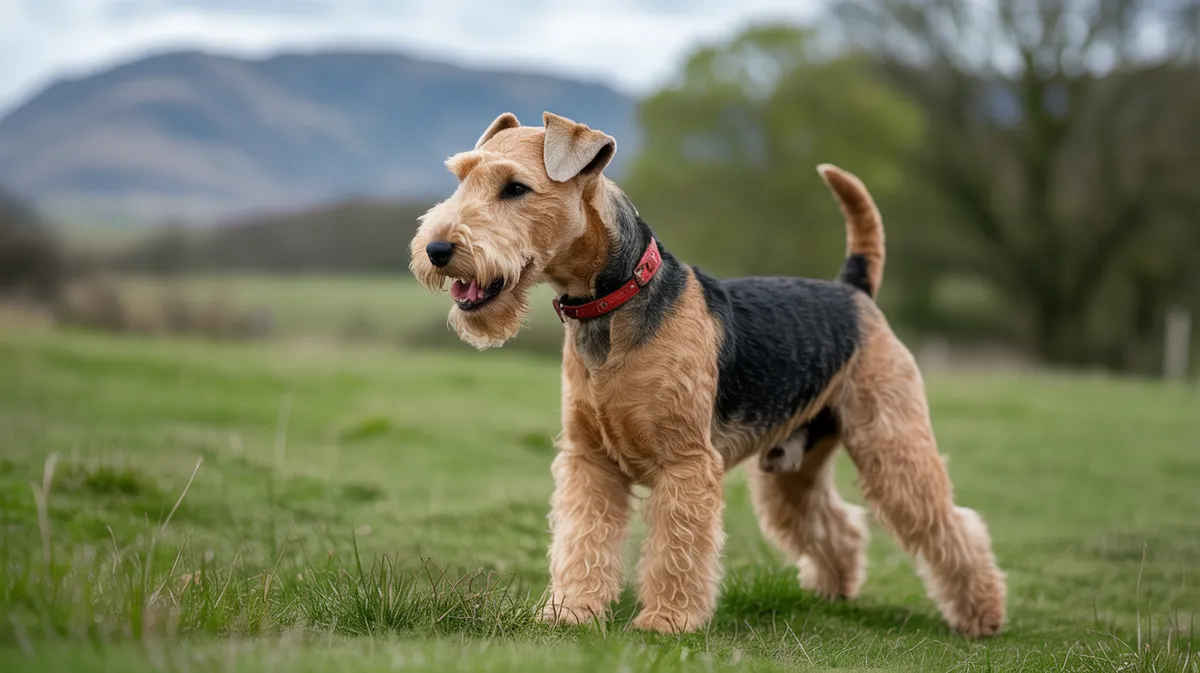
Lakeland Terrier
Canis lupus familiaris

Meet the Lakeland Terrier
The Lakeland Terrier is a small, sturdy dog breed that originated in the Lake District of England. Bred primarily for hunting foxes and other vermin in rugged terrain, it is known for its lively, confident personality and distinctive wiry coat. Lakeland Terriers are intelligent, alert, and energetic, making them excellent companions for active families. Their friendly disposition and boldness also make them standout participants in dog sports and shows.
Classification
Mammal
Habitat
Rural and urban environments, particularly in temperate grasslands and hilly regions
Diet
Omnivore
Lifespan
12-16 years
Conservation
Least Concern
Weight
7-8 kg (15-17.5 lbs)
📖Fascinating Facts
Distinctive Coat
The Lakeland Terrier has a dense, wiry outer coat and a soft undercoat that requires regular hand-stripping to maintain its classic appearance.
Origin in the Lake District
This breed was developed in the mountainous Lake District of England for its agility and ability to hunt vermin in rocky, rugged terrain.
Award-Winning Breed
Lakeland Terriers have won multiple Best in Show titles at prestigious dog shows, including Crufts and Westminster.
📋Detailed Description
The Lakeland Terrier is a compact, well-balanced breed, typically standing 33–38 cm (13–15 in) at the withers and weighing 7–8 kg (15–17 lbs). It is distinguished by its dense, harsh, and wiry double coat, which provides protection against the cold, wet conditions of its native Lake District. Coat colors include black and tan, blue, red, wheaten, liver, and grizzle. The breed has a narrow, elongated head with a pronounced stop, small V-shaped ears folding over, and dark, oval eyes that convey keen intelligence. The Lakeland Terrier's body is slightly longer than tall, with straight forelegs and strong hindquarters, giving it agility and stamina for traversing rugged terrain. Its tail is customarily docked in countries where this practice is permitted, though natural tails are increasingly seen. The breed is known for its lively, confident demeanor, high energy levels, and strong prey drive. Socially, Lakeland Terriers are affectionate with family members but may be reserved with strangers. They are highly trainable, excelling in obedience, agility, and earthdog trials, but require consistent, positive reinforcement due to their independent streak.
💡 Did you know?
Lakeland Terriers are among the few breeds that can climb and scramble over rocky terrain with great agility, a trait developed for chasing foxes into their dens.
🔬Research & Sources
Wikipedia Summary
The Lakeland Terrier is a dog breed, which takes its name from its place of origin, the Lake District in England. The dog is a small to mid-size member of the Terrier family. While independent in personality, it interacts well with owners and all family members. In the United Kingdom, the Lakeland Terrier is considered a vulnerable dog breed at risk of going extinct through low levels of breeding, according to The Kennel Club. In the United States, the Lakeland Terrier ranked 148 out of 193 breeds by number of American Kennel Club puppy registrations in 2019.
Last Modified: 11/13/2024
🎭Behavior & Social Structure
Lakeland Terriers exhibit classic terrier traits: they are alert, inquisitive, and tenacious. Historically bred to hunt foxes and other vermin, they display strong digging and chasing instincts, often investigating small animals or scents. They are generally active throughout the day, requiring regular physical and mental stimulation to prevent boredom-related behaviors such as excessive barking or digging. Socially, they are loyal and playful with family, including children, but may be assertive with other dogs, especially of the same sex. Early socialization is important to moderate their natural boldness. While independent, they respond well to structured routines and thrive on interactive play, puzzle toys, and training exercises. Their feeding behavior is typical of small omnivorous canines, but they may display food-guarding tendencies if not properly managed.
👶Reproduction & Life Cycle
Lakeland Terriers reach sexual maturity between 8 and 12 months of age, though responsible breeding is recommended after 18 months. The breed is monoestrous, with females coming into heat approximately twice a year. Mating typically occurs during the estrus phase, and gestation lasts about 63 days. Litter sizes range from 3 to 6 puppies. Females exhibit attentive maternal care, nursing and grooming pups for the first 3–4 weeks, after which weaning begins. Puppies are generally ready for adoption at 8–10 weeks. Breeding programs emphasize genetic health, as the small population size increases risk for inherited conditions such as lens luxation and Legg-Calvé-Perthes disease.
🛡️Adaptations & Survival
The Lakeland Terrier's wiry, weather-resistant coat is a key adaptation for working in the damp, cold climate of northern England. Its compact, flexible body and strong, well-muscled limbs allow it to navigate rocky hillsides and burrow into dens. The breed's acute sense of smell and hearing aid in detecting prey underground. Behaviorally, its high intelligence and problem-solving ability are evolutionary advantages for independent hunting. The breed's stamina and boldness are products of selective breeding for persistence in pursuing quarry over long distances and challenging terrain.
📚Research Sources
🎨Cultural Significance
Lakeland Terriers have a storied history as working dogs in the Lake District, prized for their ability to control fox populations threatening sheep farms. They are emblematic of the region's rural heritage and have featured in British dog shows since the early 20th century, with the breed recognized by The Kennel Club in 1921. While not widely represented in folklore or mythology, the Lakeland Terrier is celebrated in local traditions and has achieved notable success in international dog competitions, including Crufts and Westminster. Their distinctive appearance and spirited character have made them occasional subjects in art and literature related to British country life.
🔬Recent Research & Discoveries
Recent genetic studies have focused on the Lakeland Terrier's relationship to other British terrier breeds, revealing close kinship with the Border Terrier and Welsh Terrier. Ongoing research addresses inherited health conditions, with genome mapping identifying markers for primary lens luxation and other breed-specific disorders. Behavioral studies highlight the breed's cognitive flexibility and suitability for advanced canine sports. Conservation genetics projects are underway in the UK to maintain genetic diversity and monitor population trends. The breed's adaptability to urban environments is also being studied, with findings suggesting that structured enrichment and training can mitigate common behavioral challenges.
🎥Wildlife Videos

Great carrs and swirl how lake district with a lakeland terrier
Video from Andrew.
Andrew Latimer

Wild Canada - Nature's Untamed Beauty | Full Series | Free Documentary Nature
Wild Canada - Nature's Untamed Beauty | Wildlife Documentary Watch 'Darkwoods - Canada's Hidden Nature Reserve' here: ...
Free Documentary - Nature

THE AFRICAN WILD DOG: Nature’s Most Ruthless Pack Hunter Unleashed! | Animal Documentary
THE AFRICAN WILD DOG: Nature's Most Ruthless Pack Hunter Unleashed! | Animal Documentary THE AFRICAN WILD DOG: ...
WILD WORLD - Animal Documentary

Meet the Charming Lakeland Terrier #trendingvideo #wildlife #animalshorts #animal
The Lakeland Terrier originated in the Lake District of England, where it was primarily bred for fox hunting and as a working terrier.
Manimalian

working lakeland terrier pulls out possum
Roosterhuncho

Working Lakeland Terriers in the UK
Jackal's Old Country Blood
🌍Habitat Information
The Lakeland Terrier typically inhabits Rural and urban environments, particularly in temperate grasslands and hilly regions environments. Lakeland Terriers have adapted to their environments with specialized features and behaviors.
Primary Habitat:
Rural and urban environments, particularly in temperate grasslands and hilly regions
More detailed habitat information will be available soon.
🛡️Conservation Status
The Lakeland Terrier is currently classified as Least Concern. Conservation efforts are crucial for preserving this species for future generations.
Common Threats:
- 🏠Habitat loss and fragmentation
- 🌡️Climate change impacts
- 🎯Hunting and poaching
- 🏭Human-wildlife conflict
⚠️Threats & Conservation Challenges
The primary threat to the Lakeland Terrier is genetic bottlenecking due to low breeding numbers, particularly in the UK, where it is listed as a Vulnerable Native Breed by The Kennel Club. This limited gene pool increases susceptibility to hereditary diseases and reduces overall genetic diversity. Urbanization and changes in rural land use have diminished the breed's traditional working roles, leading to decreased demand. In some regions, breed popularity is overshadowed by more common terriers. Responsible breeding, health screening, and public awareness campaigns are essential for the breed's long-term viability.
🔬Scientific Classification
Scientific Name
Canis lupus familiaris
Classification Hierarchy
🔍 About Taxonomic Classification
Taxonomic classification is a hierarchical system used by scientists to classify and organize living organisms based on shared characteristics and evolutionary relationships.
The system moves from broad categories (Kingdom) to increasingly specific ones, with each animal's scientific name typically consisting of its Genus and species.
📝Community Notes
Share your observations and insights about the Lakeland Terrier with our community of wildlife enthusiasts.
Join Our Community
Sign in to share your observations and connect with fellow wildlife enthusiasts.
Sign In to ContributeNo community notes yet
Be the first to share your observations about the Lakeland Terrier!
Explore Lakeland Terrier
Select a tab above to learn more about this amazing animal.
📸Photo Gallery
No photos available for this animal yet.
🌟Discover More Wildlife
Continue your journey of discovery with more fascinating animals from our database
